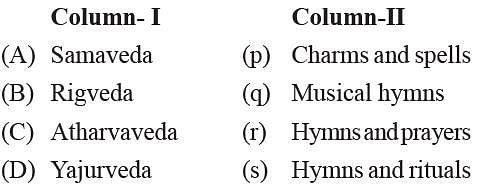Olympiad Test Level 2: A Brief History of India and the World- 2 - Class 6 MCQ
15 Questions MCQ Test GK Olympiad for Class 6 - Olympiad Test Level 2: A Brief History of India and the World- 2
Which of the following rulers belonged to Slave dynasty?
Match Column I with Column II and select the correct answer from the codes given below.


Which of the following statements are not true?
1. Sangam literature used Telugu language.
2. The literature of the Sangam Age was written mostly in the form of poetry.
3. Chora, Chera, Pallava and Pandya were ruling dynasties of South India in the Sangam Age.
1. Sangam literature used Telugu language.
2. The literature of the Sangam Age was written mostly in the form of poetry.
3. Chora, Chera, Pallava and Pandya were ruling dynasties of South India in the Sangam Age.
Who raised the slogan 'Go Back to the Vedas’?
Akbar’s court poet was
Mahatma Gandhi was a role model to not only those who fought for India’s freedom, but also people fighting for freedom the world over. What profession did he practise before he struggled for India’s freedom?
Who were the important leaders of the Khilafat Movement?
Of these, which one of the following statements is correct?
Indian National Congress was founded by
During the Indian Freedom struggle the Simon Commission was appointed to
The Julian Calendar introduced by Julius Caesar was the calendar that most countries used in the West for a long time. But the Julian calendar erred because it introduced an error of 1 day every 128 years. So that, in every 128 years the tropical year shifts one day backward. Who rectified this error and created the modern calendar?
This ancient Indian collection of Vedic Sanskrit hymns is one of the four sacred texts of Hinduism known as the Vedas. It is the most ancient of the 4 and comprises 1, 028 hymns and 10,600 verses organized into 10 books. Which Veda is this?
A general of the French Revolution, seized power and crowned himself Emperor of France. Under him, France expanded its boundaries. After disastrous French invasion of Russia, he was exiled to the island of St. Helena where he died. Who was the great French general?
He was the most famous of the Vijayanagara kings. An excellent general, he conquered much of Deccan. The famous jester-poet, Tenali Rama, is said to have been a part of his court. The king himself was an accomplished poet. Who was he?
He was the last king of delhi sultanate. Name him.
|
27 docs|62 tests
|




















